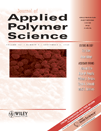A rheology study of high-energy radiolysis of a semicrystalline ethylene-propylene copolymer containing DOP mobilizer
Abstract
The radiolysis of a poly(ethylene-co-propylene), Elpro grade P 750 J, marketed by Thai Polypropylene Co. Ltd. for the manufacture of medical goods, was investigated at ambient temperature and melt rheology measured. The roles of calcium stearate, blended with the Elpro as a processing aid, and dioctyl phthalate (DOP), added in various amounts as a radical scavenger, were assessed. Following radiolysis, G′ and the viscosity of the polymer melts at 453 K both decreased with increasing radiation dose, even when the mobilizer was present. The results indicated that although the DOP did scavenge radicals, it did not protect the polymer from net chain scission in a low-dose regimen. The value of (GS − 4GX) was approximately 0.6–0.7. © 2006 Wiley Periodicals, Inc. J Appl Polym Sci 101: 3437–3441, 2006




